Pergolas featuring roofs provide an opportunity to combine shade and style in a way that is both functional and aesthetically pleasing. By choosing the right materials, design, and installation methods, homeowners can create an outdoor space that provides comfort while adding visual appeal to their home.
Juxtaposed against traditional pergolas that are open on all sides, a pergola with a roof offers additional protection from the elements while still allowing natural light to filter through into the area below.
In this article we will discuss the benefits of pergolas featuring roofs, different types of materials used in their construction, design considerations and installation tips for creating a beautiful outdoor living space.
Benefits of Pergolas Featuring Roofs
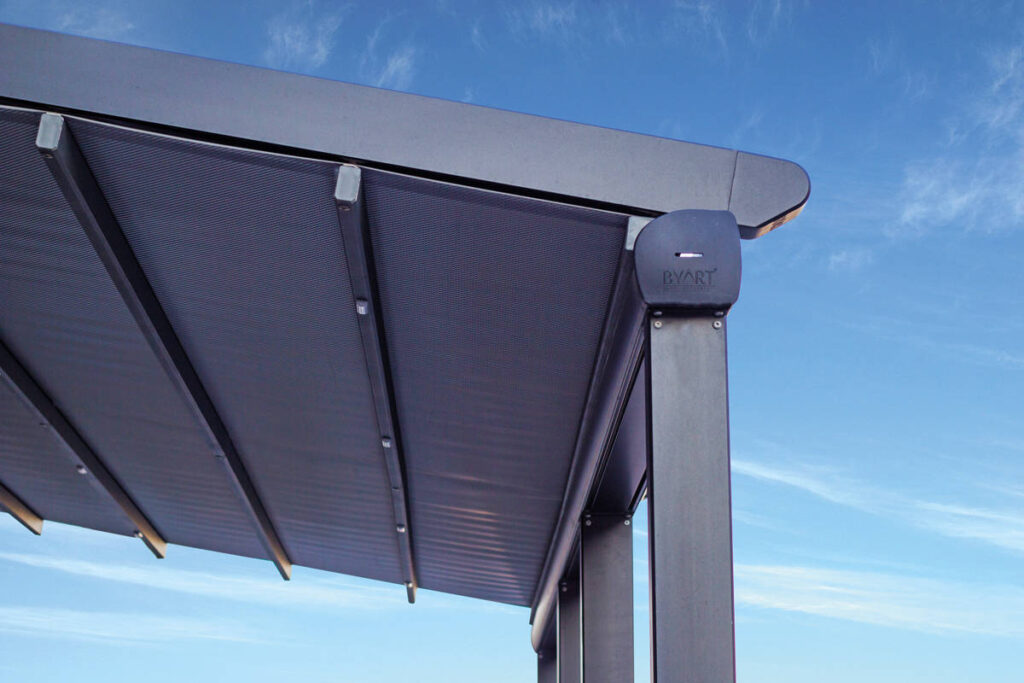
Installing a pergola featuring a roof provides the opportunity to create an outdoor living space that seamlessly blends practicality and aesthetic appeal. For those who want to enjoy the outdoors while also feeling connected to nature, a pergola featuring a roof offers budgeting options as well as functionality features.
With careful planning, it is possible to incorporate traditional or modern styles into any design plan. Whether you are looking for something small and intimate or grand and dramatic, there is sure to be a style of pergola featuring a roof that fits your vision.
Pergolas with roofs can be customized in a variety of ways depending on individual preferences. Building materials such as wood, metal, stone, or even composite materials can be used in combination with weather-resistant fabrics and other elements like lights for added interest. The size and shape of the pergola will depend on the specific area where it is being constructed as well as personal taste.
Additionally, there are plenty of designs that offer protection from sun and rain while still allowing natural light into the space below them for maximum enjoyment all year round.
When deciding on a suitable material for constructing your own unique pergola featuring a roof, it’s important to consider factors such as local climate conditions including wind speed and rain intensity; overall budget; maintenance requirements; longevity; safety; sustainability; availability of specialized services when necessary; desired look and feel; energy efficiency concerns; ease-of-installation requirements; compatibility with existing structures/landscaping/furniture/fixtures etc.; building codes & other legal restrictions etc.
Taking into account all these considerations when selecting construction materials will help ensure your finished project meets all expectations in terms of beauty, comfort, durability and cost effectiveness over its lifetime.
No matter what type or style of pergola you choose for your outdoor living space project, combining shade with style through an attractive feature like one featuring a roof will allow you to make the most out of any outdoor area while adding value to your property at the same time.
With careful planning combined with high quality materials carefully chosen based on individual needs & preferences – creating an outdoor living oasis can become reality! By considering various types of pergolas offering roofs may provide just the right solution for anyone looking forward to enhancing their outdoor living experience without compromising aesthetics or practicality.
Types of Pergolas Featuring Roofs
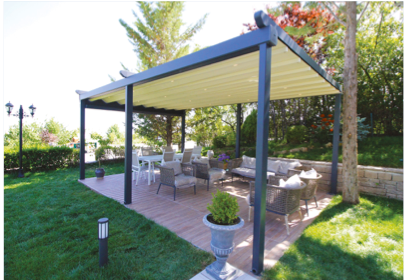
Pergolas featuring roofs can provide a unique combination of style and shade. There are three main types of pergolas featuring roofs: retractable, fixed, and louvered.
Retractable roofs can be controlled to adjust the amount of sunlight that enters the space, while fixed roofs offer a more permanent structure. Louvered roofs have adjustable blades that allow air to circulate through as well as providing some protection from sun or rain.
Each type offers homeowners different benefits depending on their needs and preferences.
Retractable Roofs
Retractable roofs provide a unique opportunity for customizing outdoor living spaces. They offer the best of both worlds: providing shade when needed and allowing sunlight to filter through when desired. With retractable roofs, one can create an atmosphere that is perfect for entertaining guests or just enjoying some time alone outdoors in the fresh air.
The advantages of this type of roof are many, including protection from rain and sun while still providing an open-air feel. Additionally, retractable roofs come in various styles, colors, and materials so it is easy to find one that complements any home’s exterior design aesthetic. Furthermore, they can be opened or closed depending on the weather conditions or preference of the homeowner making them extremely versatile and user friendly.
By combining shade and style with retractable roofs, homeowners can create a beautiful outdoor living space that they will enjoy for years to come.
The next type of pergola featuring a roof is fixed roofing systems which are designed to be permanently installed on top of a structure such as a patio or deck area. Fixed roof systems offer many benefits such as increased energy efficiency by blocking out direct sunlight and reducing heat transfer into your home during hot summer months.
Additionally, fixed roofing systems provide protection from rain and other elements like wind without sacrificing an open-air feel which is desirable for many homeowners looking to enjoy their outdoor space year-round regardless of weather conditions.
Fixed Roofs
Fixed roof systems provide protection from the elements while also offering increased energy efficiency.
Screened roofs are a popular option for pergolas due to their ability to filter light and wind.
The lattice-style design allows for air circulation, while still providing shade and privacy from outside elements.
With screened roofs, homeowners can enjoy their outdoor living space without sacrificing comfort or security.
Additionally, these roofs are often designed with removable panels so that homeowners can customize the amount of light that comes through the structure.
This provides an additional layer of control over their outdoor space, ensuring it remains comfortable no matter what the weather is like outside.
By combining style and shade with fixed roof systems, homeowners can create an inviting and secure outdoor living environment that will last for years to come.
Louvered Roofs
Louvered roofs offer a customizable design that allows users to adjust the amount of sunlight and air circulation entering their outdoor living space. This type of patio protection provides optimal sun control while still allowing for ample ventilation.
Here are three advantages of louver roofs:
- They can be adjusted so that you can enjoy shade on sunny days or let in more light when desired.
- You can customize the angle of the louvers to provide more or less airflow as needed.
- The louvers act as a natural filter, blocking out harmful UV rays and providing a comfortable outdoor living experience.
The materials used in pergolas with louver roofs vary depending on the desired style and budget, but common options include wood, metal, and aluminum. With careful consideration, users can find an ideal combination of shade and style for their outdoor living space with a louver roof pergola.
Materials Used in Pergolas
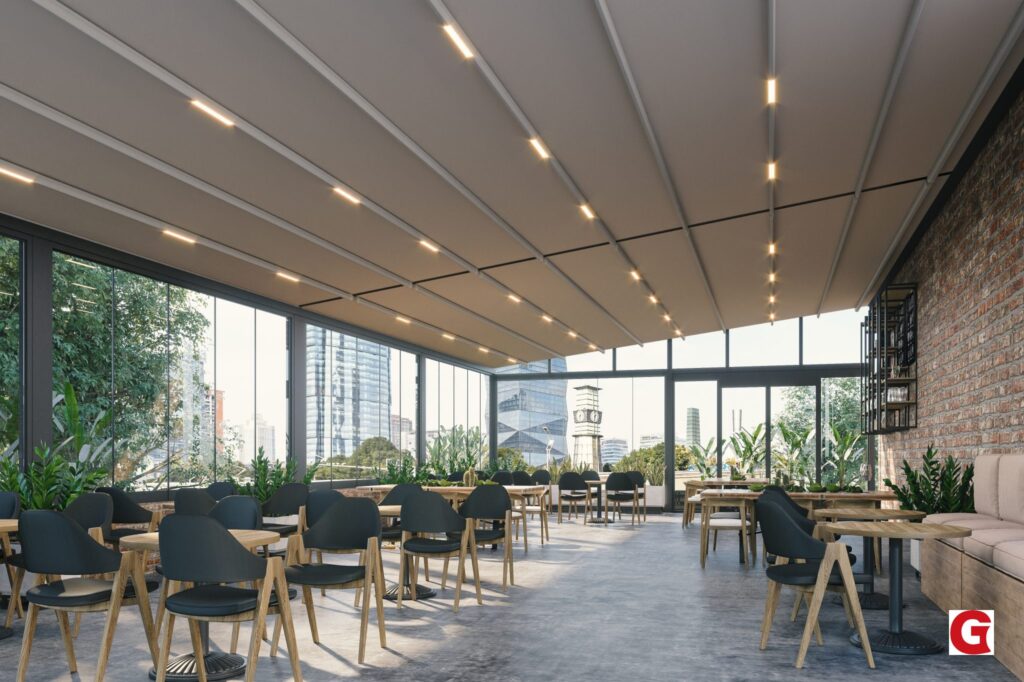
Pergolas are often constructed out of a variety of materials, allowing for customization and personalization that meet the needs of various outdoor spaces. Wood is one of the most common materials used in pergola construction due to its natural beauty, structural integrity and affordability. The type of wood used can range from softwoods such as cedar and redwood, to hardwoods such as teak or mahogany. Whatever the choice may be, it should be noted that any type of wood requires regular maintenance to ensure its longevity and sustainability benefits.
Metal is another popular material used in pergola construction because it requires little upkeep and has a long lifespan when treated correctly. Aluminum is particularly popular due to its lightweight nature, durability, corrosion resistance, and affordability. Steel can also be used but tends to require more maintenance than aluminum does since it is susceptible to rusting over time if not well maintained.
Vinyl is increasingly becoming a popular material choice for pergolas due to its low-maintenance qualities and long-lasting performance in all climates. Vinyl offers superior strength compared to other materials while still being lightweight enough for easy installation. Additionally, vinyl does not require painting or staining like other materials so it won’t need frequent upkeep like metal or wood might need over time.
Brickwork is an attractive option for those seeking a unique look with a timeless feel to their garden design. Bricks are relatively low-maintenance when laid properly but can become costly depending on how intricate the pattern or design desired may be. While bricks offer excellent insulation properties they tend to make the structure heavier than other building materials which can affect load bearing requirements during construction projects. When considering brickwork as an option for your pergola project it’s important to weigh both aesthetic appeal along with practicality before making your final decision.
Taking into account these different types of materials available for use in constructing a pergola will help you decide which best suits your needs regarding cost effectiveness, longevity and visual aesthetics when designing your outdoor space – all considerations that must be taken into account before investing in any landscaping project involving structures like pergolas featuring roofs.
Design Considerations
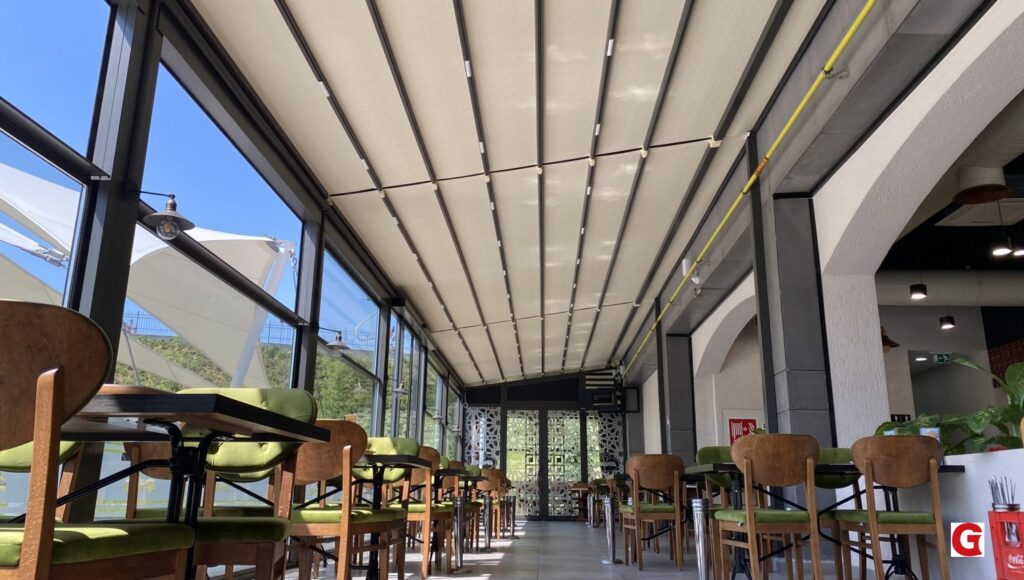
When designing a pergola, there are certain considerations that should be taken into account.
Size and shape should be determined based on the size of the area in which it will be placed, as well as its intended purpose.
Color and finish can add to the overall aesthetic appeal of the structure, while lighting can create an inviting atmosphere for those who use it.
All these factors must be considered carefully when designing a pergola to ensure it meets all expectations.
Size and Shape
By varying the size and shape, a pergola can be transformed into an elegant work of art that casts a captivating silhouette. Homeowners have many customization options to choose from when considering size and shape, allowing them to create an outdoor living space that reflects their personal style.
With careful consideration during the planning process, homeowners can select a size and shape that complements any existing architecture while providing adequate shade for the area they wish to cover. However, installation challenges may arise when constructing larger structures; unless you have experience in carpentry or structural engineering it is best to consult with a professional before making your final selection.
With the right size and shape selected, homeowners can move on to consider color and finish options for their pergolas roof.
Color and Finish
The color and finish of a pergola can be customized to create an aesthetically pleasing outdoor living space. Complementary colors can be used to create contrast and visual appeal, while textured finishes add warmth and depth.
By choosing the right colors and finishes for their pergola, homeowners have the opportunity to:
- Create a visually appealing aesthetic with complementary colors
- Add texture and depth to the overall look of their outdoor space
- Integrate their pergola into existing landscaping designs
- Enhance the atmosphere of their outdoor living area
These choices will help homeowners bring together style, shade, and comfort in one beautiful package that is sure to please family and friends alike.
Lighting is the next step in creating a perfect outdoor oasis that can provide years of enjoyment for all who enter it.
Lighting
Lighting is a key element in transforming an outdoor space into a comfortable and inviting oasis. With the introduction of modern LED lights and solar lighting, homeowners now have access to cost-effective solutions that can be used to add a touch of ambiance and style to their pergolas with roofs.
By installing LED or solar-powered lighting fixtures throughout your pergola with roof, you will be able to create a warm, welcoming atmosphere for your guests while also providing enough light for safety purposes. This type of lighting can come in many different styles or colors, allowing you to customize your space according to your individual taste and needs.
Additionally, using LED or solar lights on your pergola with roof will help you save money on energy costs as they are both energy-efficient options. With these advantages in mind, it is easy to see why many homeowners are choosing this type of lighting when designing their outdoor spaces.
From here, we can move into discussing installation tips that will ensure proper setup and use of these lights.
Installation Tips
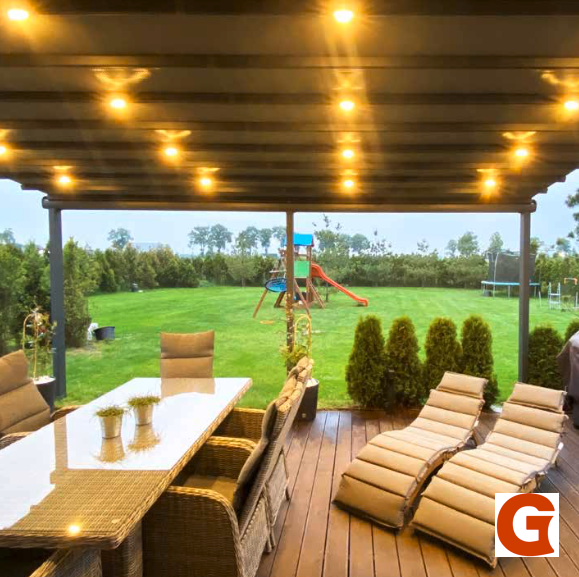
Installation of pergolas with roofs can be a complex task, requiring specialized knowledge and experience. When planning to install a pergola with a roof, it is important to obtain any necessary building permits. Without the proper paperwork in place, you may find yourself facing fines or other legal consequences.
Additionally, if your area has specific regulations about outdoor structures, ensure that you are following these rules when installing your pergola.
Proper ventilation for the roofing structure should also be considered when installing a pergola with a roof. This will help keep the area under your roof cool during hot summer days and minimize condensation buildup during colder months. The right ventilation solutions will also keep mold and mildew from forming on and around the structure due to moisture accumulation.
Finally, professional installation is recommended as this will ensure that all components are properly secured together and that no potential safety hazards exist in the area surrounding the installed structure. Using experienced professionals who have experience working with outdoor structures will give you peace of mind knowing it was done correctly and safely.
By taking into consideration these installation tips before undertaking the project of adding a roof to an existing pergola or constructing an entirely new one from scratch, homeowners can combine shade and style while ensuring their safety at all times. With careful planning ahead of time, anyone can create an inviting outdoor space perfect for entertaining family and friends alike without sacrificing aesthetics or quality construction materials.
Maintenance and Care
Regular maintenance and care of a pergola with a roof can ensure its longevity, allowing it to remain a beautiful focal point for outdoor spaces for years to come like a beacon in the night. To keep your pergola looking and functioning at its best requires periodic upkeep such as:
- Weatherproofing: This should be done every few years, or as needed depending on the conditions of your local climate. Ensure that all parts are sealed properly to prevent any water damage from rain or snow.
- Pest Control: Check regularly for signs of pests such as termites, mice, and other animals that may burrow into or feed off of wood. Regular treatments can help keep potential damage at bay.
- Cleaning: Keep the structure free from debris and dirt by cleaning it often with mild detergent and warm water solution.
By following these steps, you’ll be able to maintain your pergola’s look while also keeping it safe from the elements. With proper care and maintenance, you’ll be sure to enjoy your stylish shade oasis for many years to come without worry!
As one takes care of their pergola with a roof, they might also consider looking into the cost associated with this type of structure – an important factor when making any big purchase decision.
Cost of Pergolas Featuring Roofs
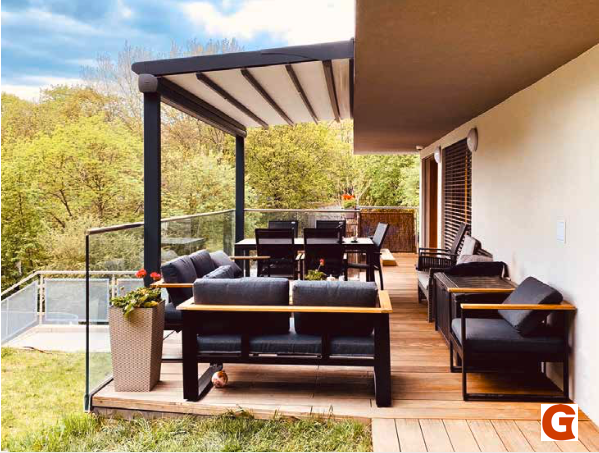
Adding a roof to a pergola can add an extra layer of protection and beauty, as well as coming with an associated cost. A cost comparison between traditional gable roofs and flat roofs for pergolas is provided below, along with some budgeting advice.
| Roof Type | Cost |
|---|---|
| Gable | $2,000 – $3,600+ |
| Flat/Pitched | $1,800 – $4,200+ |
A gable roof is the most common type of roof found on a pergola. It provides better protection from weather elements than a flat or pitched roof. Gable roofs are typically more expensive than flat or pitched roofs because they require more labor and materials to build. The cost range for this type of roof can vary significantly depending on size and customization options chosen.
Flat or pitched roofs are becoming increasingly popular for pergolas due to their lower cost and ease of installation. These types of roofs usually require less material but more labor compared to gable roofs. The cost range for these types of roofs is similar to that of a gable roof but can vary depending on size and customization options required by the customer.
When it comes to budgeting for your outdoor project, it’s important to consider all costs associated with adding a roof to your pergola such as materials, labor costs, permits fees (if applicable), etcetera. Additionally, it’s wise to shop around for the best price available in order to ensure you get the best value for your money. With careful planning and research ahead of time you’ll be able to find the right option that fits your needs without breaking the bank! Transitioning into finding a qualified contractor who can help install your chosen style is key in ensuring quality construction work that will last in any environment conditions.
Finding a Qualified Contractor

Finding a qualified contractor to install your chosen pergola roof is essential in order to ensure quality construction and longevity; the Bureau of Labor Statistics estimates that more than 1 million people are employed as general contractors across the United States. With so many options, it can be difficult to narrow down your search for the best match.
Here are some tips on how to find a reliable contractor:
- Research: Read reviews online, ask for referrals from friends and family, and look into each contractor’s credentials before making a final decision.
- Communication: Establish clear communication with the contractor up front by asking questions about their experience, qualifications, and availability. This will help you determine if they are right for the job.
- Sourcing Materials: Ask what materials they use and where they source them from so you know you’re getting high-quality products. Pre-planning designs is also important as this helps avoid delays or unexpected costs due to incorrect measurements or lack of necessary supplies.
- Payment Terms: Make sure to discuss payment terms before any work is done so there are no surprises down the line when it comes time to pay for services rendered.
No matter which contractor you decide on, always make sure that they have insurance coverage in case something goes wrong during installation or repairs need to be made later on down the road. Taking these steps prior to hiring someone can save headaches in the long run and give you peace of mind knowing that your project will be completed properly and safely.
Frequently Asked Questions
How long does a pergola featuring a roof typically last?
Pergolas featuring roofs are constructed from durable materials, making them long-lasting and energy efficient. These structures provide protection from the elements while adding an aesthetically pleasing addition to a backyard or outdoor space.
Depending on the type of materials used and how well it is maintained, a pergola with a roof typically lasts 10-15 years or more. To ensure maximum longevity, consider investing in high quality materials that are designed to withstand harsh weather conditions.
With proper maintenance and care, these structures can provide many years of enjoyment for you and your family.
Are there any additional permits or licenses required for installing a pergola featuring a roof?
When installing a pergola featuring a roof, additional permits or licenses may be required depending on the local regulations and zoning laws. Installing costs can vary significantly depending on the size and complexity of the project.
It is important to factor in maintenance costs as well when planning for such a project. Proper maintenance can help extend the life of a pergola featuring a roof, ensuring that it stands up to different weather conditions over time.
Does a pergola featuring a roof provide any additional protection from the elements?
A pergola featuring a roof can provide additional protection from the elements. However, there is evidence that suggests there are trade-offs to consider when deciding whether to install a roofed pergola.
For example, research shows that the shade quality of a roofed pergola may be lower than an unroofed one due to the need for greater maintenance costs associated with it. Additionally, depending on the materials used to construct the roof, further protection from the elements may not be provided.
Therefore, it is important for consumers to assess their individual needs and weigh these factors before making a decision about installing a pergola featuring a roof.
Are there any special considerations for a pergola featuring a roof in windy climates?
Pergolas featuring roofs can be beneficial in windy climates, as they provide additional protection from the elements.
However, there are special considerations to take into account when weatherproofing and windproofing a pergola featuring a roof. Properly sealing joints and using wind-resistant materials such as metal or aluminum can help mitigate damage caused by extreme winds. Additionally, anchoring the structure securely to the ground is essential for added stability during high winds.
Taking these measures will ensure that a pergola with a roof can withstand even the strongest of wind conditions.
Are there any special features or accessories available for pergolas featuring roofs?
When installing pergolas featuring roofs, there are many special features and accessories to consider.
Various types of roofing materials can be used, such as aluminum, plastic, or wood; each one having their own installation tips and maintenance costs.
Additionally, accessories like retractable canopies and awnings can be used to extend the area of shade coverage provided by the roof.
Furthermore, motorized systems are available for automated opening and closing of these covers.
The creative use of these features allows homeowners to combine style with functionality in order to create a unique outdoor living space.
Conclusion
A pergola featuring a roof is an excellent addition to any outdoor space, providing both shade and style. The many types of designs and materials available ensure that everyone can find a fit for their individual needs. Careful design considerations should be taken into account before installation to guarantee the desired outcome.
Furthermore, with suitable maintenance, these structures can withstand the test of time. Despite initial costs being high, the long-term benefits are sure to be invaluable in ensuring your outdoor space remains a pleasant haven for years to come. As such, it behooves homeowners to invest in a quality pergola featuring a roof to modernize their abode’s aesthetic appeal.
